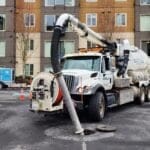The Multi-Sector General Permit (MSGP) Has Changed
by Anna Espenhahn, Marketing Coordinator
Stormwater regulations are never stagnant for long, and with the recent transition to a new white house administration, changes are already in motion to existing water legislation. On Jan. 15, 2021, President Joe Biden signed the fifth iteration of the Multi-Sector General Permit (MSGP) to strike industrial stormwater discharge regulations effective March 1, 2021, and active for the next five years. While this is not an all-encompassing report, below is a breakdown and analysis of MSGP requirements regarding stormwater management.
The 2021 MSGP covers 29 sectors of industrial activity:
- Timber Products
- Paper Products
- Chemical Products
- Asphalt/Roofing
- Glass, Clay, Cement
- Primary metals
- Metal Mining
- Coal Mines
- Oil and Gas
- Mineral Mining
|
- Hazardous Waste
- Landfills
- Auto Salvage Yards
- Scrap Recycling
- Steam Electric Facilities
- Land Transportation
- Water Transportation
- Ship/Boat Building, Repair
- Air Transportation
- Treatment Works (WWTPs)
|
- Food Products
- Textile Mills
- Furniture and Fixtures
- Printing, Publishing
- Rubber, Misc. plastics
- Leather Tanning/Fishing
- Fabricated Metal Products
- Transportation Equipment
- Electronic, photo goods
- Non-Classified Facilities
|
Application deadlines
Industrial activity that is not covered by the Environmental Protection Agency (EPA) permit and instead follows state permits is not required to comply with Environmental Protection Agency’s MSGP. However, it is common for state permits to mirror or mimic the EPA’s regulations, so it is encouraged to review EPA standards as states may adopt these standards in the future.
Existing facilities’ Notice of Intent (NOI) to get covered by the new permit are due May 30. New facilities’ NOI to receive coverage by the new permit must be submitted at least 30 calendar days before beginning discharge.
All facilities covered in 2021 must submit their first annual report by Jan. 30, 2022.
Monitoring and Inspection Requirements
Throughout the duration of your coverage, inspections and visual assessments must be conducted. Inspections and inspection reports completed by qualified personnel should be performed on a quarterly basis for the entirety of permit coverage. Visual checks should also be performed, with quarterly visual assessment of grab sample from each discharge point and within the first 30 minutes of a storm event if possible, both with documentation. The permit specifies what areas need to be inspected based on sector, but examples include exposure of potential pollutants, spills or leaks, unauthorized non-stormwater discharges, and overall poor housekeeping.
A variety of site monitoring is also required under the Environmental Protection Agency MSGP permit.
Indicator Monitoring
New to the 2021 permit, indicator monitoring on a quarterly basis is required for pH, TSS, COD and bi-annually monitoring for PAHs is required in the first and fourth years for certain facilities. Reporting is required; however, exceedance does not result in a violation.
Benchmark Monitoring
Benchmark monitoring may be required quarterly throughout the first year. The 2021 iteration of the permit may also require monitoring in the fourth year of coverage based on your sector. Benchmark values in 2021 have been updated from the 2015 permit. The iron and magnesium benchmark has been removed due to lack of documented toxicity, while aluminum, copper, selenium, and cadmium were revised based on the new final Environmental Protection Agency water quality criteria. No violations are issued based on reported values.
Effluent Limitation Guidelines (ELG) Monitoring
Effluent limitation guidelines monitoring is required annually for subject facilities (stated in part 4.2.3 of the permit). If an exceedance is identified, this will result in a violation.
Monitoring for Impaired waters without a Total Maximum Daily Load (TMDL)
Annual monitoring must occur throughout the first year for all impaired pollutants. Additionally, the 2021 permit now requires annual monitoring for pollutants associated with industrial activity and are benchmarks during the fourth year of coverage. If pollutants are found during any monitoring, they must continue until no pollutants are detected.
Required Corrective Actions and Reporting
Review and revision of SWPPP, implementation of corrective action is required within 14 days if any of the following conditions occur:
- Unauthorized release/discharge
- Exceedance of ELG monitoring limitations
- Stormwater controls do not meet water quality standards
- Stormwater controls are not in place or are not functioning
- The assessment shows evidence of stormwater pollution
Additional Implementation Measure (AIM) are required based on benchmark monitoring. If the four-quarter average exceeds the benchmark threshold, or fewer than four samples are taken, but a single sample exceeds benchmarking threshold by more than 4x benchmark, exceedance is triggered. Previously if this were to occur, operators would review control measures and identify any necessary modifications were necessary. However, the updated 2021 permit has implemented a three-level exceedance procedure.
Level 1: Begins when the first exceedance even occurs. SWPPP and control measures must be reviewed, and monitoring must continue until acceptable levels are obtained. If level one is in place and another exceedance occurs, the next level is triggered.
Level 2: Additional pollution prevention and good housekeeping measures must be implemented, and monitoring should continue until there is no exceedance. If another exceedance event occurs while in level two, level three begins.
Level 3: Permanent structural source and treatment controls must be installed and infiltration should be considered. Monitoring must continue until levels are within limits.
President Joe Biden’s Executive Order, “Tackling the Climate Crisis at Home and Abroad” signals a change in how the United States and its agencies will be addressing environmental concerns across the country, including water. In this order, President Biden announces his 30×30 initiative to conserve 30% of our lands and waters by 2030. As part of this initiative, and many others addressed throughout the executive order, continued change to stormwater regulations should be expected. It is important to continue looking to the future of regulations as part of your continued responsible stewardship of our public waters.
Partnering with a Stormwater Provider
Avoid violations and ensure your stormwater remains within 2021 EPA MSGP guidelines by partnering with AQUALIS. Our regulator relationships build through years of experience allow AQUALIS professionals to stay updated with all local, state, and federal regulations. If you have questions regarding your industrial stormwater systems, contact AQUALIS for a free consultation.

 Kenosha, Wis. Highway KR Regenerative Stormwater ConveyanceThe Root-Pike Watershed Initiative Network Kenosha County, and others worked with AQUALIS to design and implement an innovative solution for stormwater control along Highway KR.
Kenosha, Wis. Highway KR Regenerative Stormwater ConveyanceThe Root-Pike Watershed Initiative Network Kenosha County, and others worked with AQUALIS to design and implement an innovative solution for stormwater control along Highway KR. Durham, N.C. Sinkhole Leads to Stormwater System RehabilitationThe tenant on this property noticed a depression that opened to the ground below and notified the property owners.
Durham, N.C. Sinkhole Leads to Stormwater System RehabilitationThe tenant on this property noticed a depression that opened to the ground below and notified the property owners.


